Matador Network's Blog, page 956
December 17, 2019
Boeing suspends 737 Max production

The saga of the Boeing 737 Max isn’t over just yet. After months of grounding the aircraft and rolling out new updates, Boeing has decided to suspend production of the 737 Max in January. Despite the drawdown in production, Boeing has said that it does not plan to lay off or furlough workers at the Washington factory where the model is manufactured, although some of those workers will be temporarily reassigned.
A review of the planes by the Federal Aviation Administration (FAA) is currently underway, and will continue into 2020 — longer than Boeing had initially hoped. The planes have been grounded since March 2019 after two fatal crashes prompted an investigation into the model’s failures, and this prolonged lapse in service has finally forced Boeing to pump the breaks on manufacturing.
In a statement, Boeing said, “We know that the process of approving the 737 Max’s return to service, and of determining appropriate training requirements, must be extraordinarily thorough and robust, to ensure that our regulators, customers, and the flying public have confidence in the 737 Max updates. The FAA and global regulatory authorities determine the timeline for certification and return to service. We remain fully committed to supporting this process. It is our duty to ensure that every requirement is fulfilled, and every question from our regulators answered.”
It’s not yet clear how long Boeing will suspend production of the 737 Max, though US airlines have taken the plane off their schedules through at least March. Until then, the approximately 400 planes that have been manufactured since the grounding began will continue to sit in the manufacturing facilities, waiting for the green light from regulators. 

More like this: 7 artsy plane interiors that make flying a whole lot cooler
The post Boeing will halt production of the 737 Max in January appeared first on Matador Network.

December 16, 2019
Monarch butterflies in Mexico

Each year, with the arrival of winter, monarch butterflies make the long and difficult journey from Canada and the US south to Mexico to hibernate. Seeing the butterflies up close is so spectacular — and their migration so historically important — that the Monarch Butterfly Biosphere Reserve, located in the state of Michoacán, was declared a UNESCO World Heritage site in 2008. The first of the butterflies arrive in early November, and there are many different sanctuaries you can visit to see them up close in the forests of oyamel trees.
The mystery and cultural significance behind the monarch butterfly migration
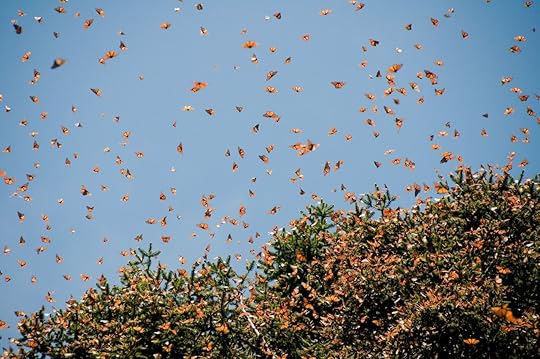
Photo: Noradoa/Shutterstock
The origin of the monarch butterfly migration from Canada to Mexico each year is shrouded in mystery — monarchs are the only butterflies known to migrate both directions each year. Scientists still aren’t quite sure how monarchs are able to find their way to their annual hibernation spot in Mexico each year.
What they do know is that for thousands of years, the Purépecha people have recorded the monarch butterflies’ arrival in the same area of Mexico, at the same time each year. Culturally, the monarch butterflies’ arrival holds a lot of significance. The monarchs start arriving on November first, which is the beginning of the Day of the Dead celebrations in the country. As such, their arrival is ideally timed to honor deceased family members and loved ones. Many believe the monarchs arrival into the Sierra Madre mountains are the souls of their deceased ancestors returning to visit their living relatives.
When and where to see the monarch butterflies in Mexico

Photo: Natalia Gurieva/Shutterstock
Even though the monarchs start arriving at the beginning of November, many butterfly sanctuaries don’t actually open their doors to the public until the second or third week of the month. That way, when visitors arrive, they can expect to see a good amount of butterflies.
The monarch butterflies spend their winters in the Sierra Madre mountains in the states of Mexico and Michoacán, west of Mexico City. Come late March, the butterflies return north, following internal instinct along with external clues such as weather patterns and the position of the sun. To see the butterflies between November and March, check out one or several of the many sanctuaries open to visitors.
1. Piedra Herradura Sanctuary
The Piedra Herradura Sanctuary is located in the state of Mexico, and it is the easiest one to get to if you are coming from Mexico City (about a two-hour drive). A guide will take you up the mountain to see the butterflies either on foot or on horseback depending on what you choose. It is quite a steep incline, so come prepared for a workout to get up to the top.
Entrance fee for a two-hour visit to Piedra Herradura $3.70 for adults. You can also choose to ride a horse up the steep incline of the mountains for $10.50.
2. Cerro Pelon Sanctuary
There are two separate entrances at the Cerro Pelon Sanctuary. One is in Macheros, and the other is in El Chapulin. Cerro Pelon is a three-hour drive from Mexico City and located in the state of Mexico. It is known for being more rugged and less crowded than other sanctuaries. Choose to walk or ride up via horseback to see the butterflies at Cerro Pelon, where entrance fees start at around $2 per person.
If you’d like to spend the night before or after visiting Cerro Pelon, head to the nearby JM’s butterfly B&B. The staff at JM’s also leads tours up to Cerro Pelon, but the fees are a little higher due to transportation costs.
3. El Rosario Sanctuary
El Rosario Butterfly Sanctuary is the most popular place to see the monarchs in Michoacán. The Sanctuary is located near the beautiful pueblo magico (“magic town”) of Angangueo. El Rosario is about a four-hour drive from Mexico City. The hike up the mountain to see the monarchs is steep at El Rosario and takes an hour to trek. There is also the option to see the butterflies on horseback.
There are guides, horses, food and drinks, as well as a spot to buy handicrafts at the base of El Rosario. Entrance fees at El Rosario butterfly Sanctuary start at $2.60.
4. Sierra Chincua Sanctuary
The Sierra Chincua Butterfly Sanctuary is located in Michoacán and is also near Angangueo. Sierra Chincua is about a three-and-a-half-hour drive from Mexico City. At Sierra Chincua, you will be led by a guide to see the butterflies either on foot or by horseback. It can take anywhere from 45 minutes to an hour to arrive at the butterfly viewing area.
Aside from hiking and horseback riding to see the butterflies, there are also nearby zip lines, a climbing wall, and suspension bridges to check out. Entrance fees at Sierra Chincua start at $2.40.
How to behave when viewing the monarchs

Photo: SlavoMrug/Shutterstock
While seeing the monarch butterflies up close is a wonderful activity to partake in, it is important to remember that the monarch butterfly population has been rapidly declining since the 1980s. In fact, it was estimated that in the 1980s there were three to 10 million monarch butterflies in North America. Scientists now believe that there are only 30,000 left.
In order to take care of the species, there are rules that visitors must follow when visiting the butterfly sanctuaries. First and foremost is to act as though you’re in a library — avoid loud conversations and generally keep quiet. It is also important to not cross into any out-of-bounds areas and to always follow the instructions of your guide. Most sanctuary websites also indicate that smoking is prohibited.
What to expect during your visit to a butterfly sanctuary in Mexico

Photo: Isabelle OHara/Shutterstock
The first thing to be prepared for at any of these sanctuaries is a steep hike or horseback ride into the mountains to see the butterflies on your visit. Make sure you bring appropriate clothing, sunscreen, and lots of water. And again, remember to keep quiet when you get close to the butterflies and follow all the instructions from your guide.
The best part is the sheer amount of butterflies you will see — thousands of monarchs huddle together on the trees to keep warm. There are so many that the trees will be transformed into fluttering orange giants. You’ll also see thousands of butterflies flying from tree to tree overhead in a sea of orange and black wings. 

More like this: The largest pyramid in the world isn’t in Egypt. It’s in Mexico.
The post Where to see thousands of migrating monarch butterflies in Mexico this winter appeared first on Matador Network.

What are yurts, how to stay in one
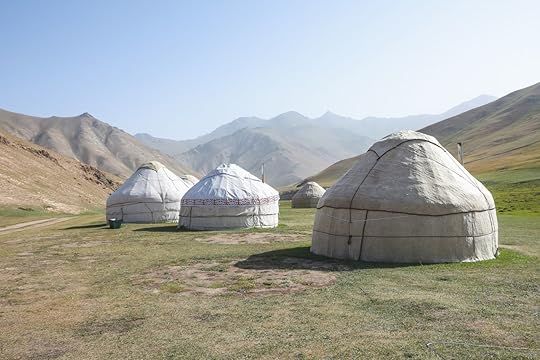
Known as yurts in the Stans and gers in Mongolia, the movable homes of Central Asian nomads are becoming a more and more popular form of accommodation for both backpackers traveling along the ancient Silk Road routes and tourists looking for alternative forms of accommodation in Western countries. Thanks to the success of community-based tourism programs in Kyrgyzstan and the loosening of visa regulations in once hard-to-access countries like Uzbekistan or Tajikistan, reaching remote camps to experience a lifestyle that has characterized this corner of the world for millennia is now easier than ever.
Portable and easy to assemble, traditional yurts are built of felt and waterproof skins covering a structure made of bent wooden poles. While simple in appearance, these circular tents offer great protection from the fierce climate of the steppe, shielding against the heavy winds that blow unhindered in the barren flats and offering enough insulation to resist extreme temperatures.
The roots of the yurt
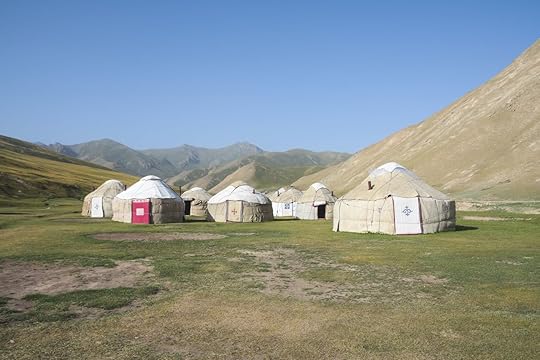
Photo: Angelo Zinna
It’s not by chance that the nomad’s dwelling is most often associated with Mongolian culture. The word ger in Mongolian means “home,” and still today over 50 percent of the population of Mongolia lives in the tent that has become a national symbol, carrying forward a tradition that is thought to have existed since at least 600 BC. This said, borders and nomadism don’t go well together, and it would be reductive to refer to the iconic structure as a strictly Mongolian phenomenon.
Long before Marco Polo would describe the gers he shared with Mongols during his travels between 1274 and 1291, Herodotus had already written about the yurts used by Scythians living in the regions surrounding the Caspian and Black seas in 440 BC. While nomadic groups in Europe and Asia had adopted yurt-like structures that could be easily transferred from one place to the next one, their propagation is primarily linked to the conquests of Gengis Khan and his successors. By reaching Turkey and Europe in the 13th century, the Mongols exported a lifestyle that became popular among nomadic tribes of Central Asia, the Middle East, and Eastern Europe.

Left to right: Kirghiz stamp displaying the country’s emblem and Kazakh flag (Photo: rook76 + Stakes/Shutterstock)
Until not too long ago, yurts could be found in Iran, Turkey, and rural parts of Hungary. It is in the Stans of Central Asia, however, that these movable homes have rooted themselves and acquired iconic status. Today they can be found in remote jailoos, the summer highland pastures where herders take their animals during the warm summer months. The yurt’s shanyrak — the wooden crown that holds the poles together from the top of the roof — appears on both Kyrgyzstan’s flag and Kazakhstan’s national emblem.
A simple and efficient build
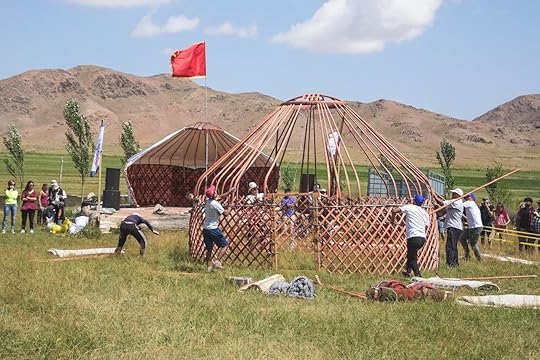
Photo: Angelo Zinna
Setting up a yurt can take up to eight hours depending on its size. However, the speed record for yurt building belongs to the Kyrgyz team that participated at the 2018 World Nomad Games — they took only seven minutes and 46 seconds to build their tent.
The first step in building a yurt is setting up the circular structure on which the roof will be mounted. Although metal yurts exist today, in most cases the lattice is still made with a series of criss-crossed, light wooden poles that collapse into each other and can be transported in a cinch.
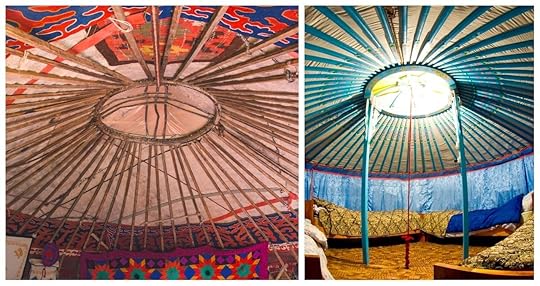
Left to right: Interior ceiling structure of a yurt versus that of a ger (Photo: Angelo Zinna + withGod/Shutterstock)
Once the lattice is set up and secured with the help of leather ropes, the roof is placed on top. There is a slight difference between the roofs of Mongolian gers and Central Asian yurts. In the first, the roof is made of perfectly straight poles, known as uni, while in the second they are bent to form part of the walls. Because of this, Mongolian gers tend to be lower in height than their Central Asian counterparts.
The crown is attached to three poles then balanced on the lattice and fastened with ropes. Once the crown is stable, up to 100 additional poles are added to complete the skeleton of the yurt. Finally, layers of fabric are placed on the outside to provide insulation and protection against the elements.
When complete, the interior of the yurt can be decorated with carpets and minimal furniture. A stove usually keeps the room warm, and the crown can be left open for ventilation. Most yurts are designed to sleep a family of four to five people, but larger structures capable of hosting up to eight people exist as well.
Where to find yurt camps
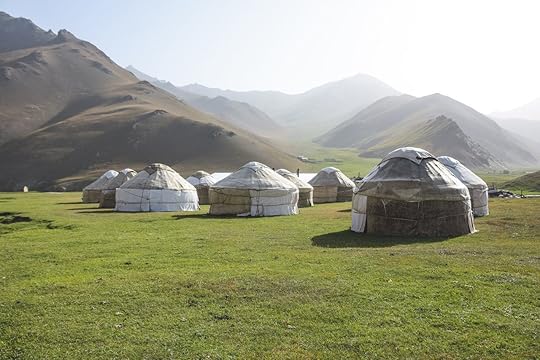
Photo: Angelo Zinna
Yurt camps can be found all over Central Asia, with the biggest concentration being in Mongolia and Kyrgyzstan. They vary in size, but most often camps that host tourists are family-managed businesses where up to 10 tents are reserved for visitors while the rest are used by the locals. Most are only open in the summer months, with some exceptions for low-altitude camps near bigger cities.
Although yurt camps are normally found in some of the most remote corners of the world, getting there is fairly simple if you plan ahead. In Kyrgyzstan, the Community Based Tourism Association can help you find camps to break up multi-day hiking adventures, while in Mongolia ger stays are an essential part of any Gobi Desert tour. Some rental gers are even available on Airbnb.
Among the most incredible destinations for yurt camping in Kyrgyzstan are Song Kul lake, a jailoo positioned on the shores of an alpine lake at an altitude of 10,000 feet; Tash Rabat, where camps surround a 15th-century caravanserai; and the Valley of Flowers, near Jeti Oguz. Sleeping in a yurt is also possible in Kazakhstan, Tajikistan, and Uzbekistan.
The Kyrgyz village of Kyzyl-Too is a great place to go if you want to learn more about the craft of yurt building. This sleepy town on the southern shore of Issyk-Kul lake is known as the Kyrgyz capital of yurt-making, and it is possible to participate in workshops and learn all the tricks of the trade. 

More like this: 7 of the coolest-looking traditional houses around the world
The post The traditional Central Asian dwelling is a majestic piece of temporary architecture appeared first on Matador Network.

LGBTQ travel guide to Amsterdam
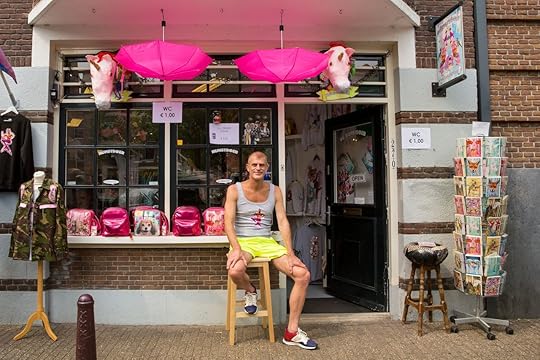
The Dutch word gezellig has no proper English equivalent but roughly translates to “cozy,” “pleasant,” or “comfortable” — a feeling of well-being that arises from a person or place. As an LGBTQ+ traveler, to visit Amsterdam is to know what this means.
Gezellig lives in the tulips that spring from the flower boxes in front of 17th-century townhouses and the choral chime of bike bells cling-clanging through the air. Strolling along the snug houseboats that line the city’s iconic canals is gezellig, as is drinking craft beer with good friends in a classic brown cafe. Most importantly, Dutch locals inspire the feeling of gezellig. They’re a people so inviting you may be caught off guard by their kindness. Internationally known for their liberal do-as-you-please laws, it should be no surprise that Amsterdam is a favorite destination for the LGBTQ+ community. Accepting all people is a cornerstone of Dutch culture, and Amsterdam’s overwhelming support of queer folks is perhaps the most gezellig thing of all.
On the flip side, Amsterdam is currently dealing with the strain of over-tourism. The city may be more postcard-perfect than Disney World, but this popular destination is no theme park — it’s home to around 800,000 residents who want you to respect them as much as they respect you. From marijuana dispensaries (known as coffeeshops) to live sex shows, it can be easy to over-indulge. Remember to partake responsibly — being a belligerent or unaware tourist is the exact opposite of the gezellig lifestyle. Rather than spending your entire vacation in the Red Light District, check out hip neighborhoods like De Pijp, Oud-West, and NDSM wharf. Moreover, try traveling outside of peak season — July and August — and enjoy the benefits of fewer crowds and cheaper deals by taking a trip sometime between March and April or September and November.
A brief history of LGBTQ scene in Amsterdam
Amsterdam has been a global leader in the fight for LGBTQ rights for over 200 years. In 1811, the country decriminalized homosexual activity. The first gay bar, operated by an out lesbian, opened its doors in 1927. The COC, a gay rights organization, was founded in Amsterdam in 1946 and is the world’s oldest continually operating organization of its kind. In 1987, the Homomonument became the first memorial to homosexuals persecuted in World War II, and in 2001, the Netherlands became the first country to legalize same-sex marriage.
Knowing all this, it may seem surprising that Europe’s most historically accepting city lacks a true gayborhood. Although sections of streets like Kerkstraat and Reguliersdwarsstraat are definitively queer, Amsterdam’s LGBTQ scene is as far-ranging and free as the city’s liberal laws. Luckily, the areas where queer folks congregate are within easy walking distance or a short tram ride of one another.
Bars
SoHo
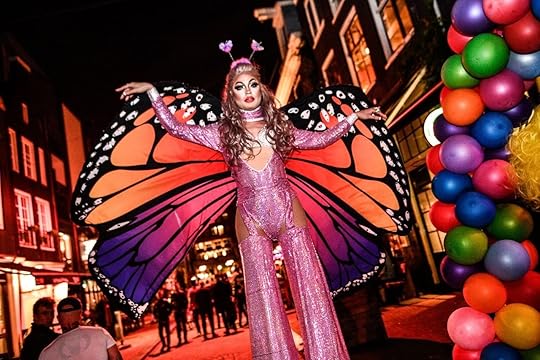
Photo: SOHO – Amsterdam/Facebook
Don’t be fooled by the classy wood-paneled interior and Victorian staircase in this Reguliersdwarsstraat joint — once the weekend rolls around, this bi-level bar is pumping with trashy pop music until 4:00 AM. The outdoor patio offers a quiet escape from the busy indoor shenanigans, as does the smoking room upstairs.
SoHo is centrally located in the biggest LGBTQ-friendly section of Amsterdam, and it’s steps away from popular gay bars Taboo, Bar BLEND, and Exit Cafe. For those who prefer bud to beer, a queer-friendly coffeeshop, The Otherside, is a half-block away on the corner of Reguliersdswarsstraat and Koningsplein.
Where: Reguliersdwarsstraat 36
Cafe t’ Mandje
Cafe t’ Mandje (“the basket”) holds the honor of being Amsterdam’s first official gay bar. Opened in 1927 by the brazenly out lesbian Bet van Beeren, the bar operated until 1982 and then re-opened in 2008. The interior is covered from floor to ceiling with photos and memorabilia from the bar’s heyday, serving as a time capsule for the city’s queer history. More traditional brown cafe than a gay bar, this all-are-welcome establishment is perfect for grabbing a beer and chatting with old friends.
Where: Zeedijk 63
Club NYX

Photo: Club NYX/Facebook
Located in a four-story former carriage house, NYX is a graffiti-strewn dance club that attracts a mixed crowd of queer folk and their allies. The venue has a little something for everyone, including performances by international drag artists, world-renowned DJs, and a new style of music on each floor. Be sure to use the upstairs WC to see a DJ working the potty-adjacent turntable. Every Saturday night’s 3x party specifically caters to the gay community.
Where: Reguliersdwarsstraat 42
Spijker Bar
Spijker originally opened in 1978 as a leather-and-levis bar, and while it’s a lot laxer on dress code these days, it still attracts a similar clientele. Red-lit erotic art lines the walls, two dueling TV screens behind the bar play cartoons and hardcore content, and a pool table in back attracts men looking for some action. (Not that kind of action — if you want to play with real balls, your best bet is to check out Club Church one block over.) Saturday’s bingo night, hosted by drag queen Miss Didi Licious, is a popular time to visit.
Where: Kerkstraat 4
PRIK
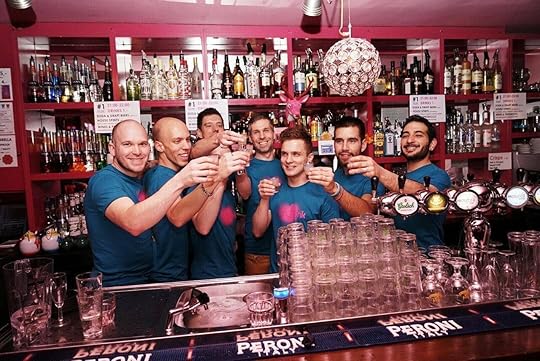
Photo: PRIK/Facebook
One can’t help but think pink in this cozy city-center gay bar. The sign out front is pink, the walls inside are pink, even the prosecco on tap is pink! And while prikmeans “bubble” in Dutch, the double entendre tickles me pink, too. The bar also offers light bar bites for those in need of a nosh.
Where: Spuistraat 109
Bar Buka
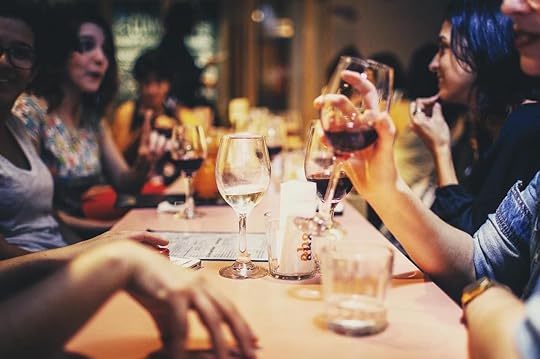
Photo: Bar Buka Amsterdam/Facebook
Buka, the Indonesian word for “open,” is a bar for all people, but this comfy spot in de Pijp caters mainly to Amsterdam’s lesbian community. The food menu of tasty bar treats features a section entitled “Fries Before Guys,” and the specialty cocktails include names like “Pink Pleasure” and “Lipstick Maffia.” The bar is open from Wednesday to Sunday.
Where: Albert Cuypstraat 124
Cruise bars and nightclubs
Club Church
Get on your knees, all fours, or whatever consensually works for you to worship at the altar of this gay cruise club. An all-inclusive and sex-positive space, Church celebrates a bunch of fetish subcultures with various theme nights throughout the week. Wednesday nights are no-clothes-allowed, Thursdays are for dancing and drag, Fridays are underwear-only, and Saturdays are for kinky locker room gear. Check the website for schedule updates; be prepared to check your clothes with the doorman once you arrive.
Where: Kerkstraat 52
Eagle Amsterdam
This three-floor maze for leather lovers is a bar, dance hall, and cruise club all rolled into one. You can wander the basement’s darkrooms looking for lust, hang in the communal cruising area on the top floor, or dance until dawn all weekend long while DJs spin tunes on the main landing. Check the website’s schedule for special fetish nights. You may want to leave the ladies at home — this is generally a men’s-only establishment. The bar is open Tuesday to Sunday in the Red Light District.
Where: Warmoesstraat 90
Nieuwuzijds (Gay Sauna)
If you’re looking for a soak, steam, or something more obscene, this gay sauna has got you covered — with a towel, at least. The facilities include a Finnish sauna, jetstream jacuzzi, Turkish steam room, private cabins, and a lounge with a fully stocked bar. Though the vibe is cruisy, you can enjoy the well-maintained amenities without the hanky-panky, particularly on Wednesdays when aufgüss ceremonies are held in the dry sauna. Every second Saturday is for people of all gender identities and sexual orientations; every last Saturday is for bears and their admirers.
Where: Nieuwezijds Armsteeg 95
Parties
Like many urban areas, Amsterdam’s gay bar scene has seen a decline in recent years. Now, some of the city’s best queer nightlife events are one-night-only parties that happen on a semi-regular basis. Here, you’ll find a younger, hipper crowd of in-the-know locales.
Is Burning
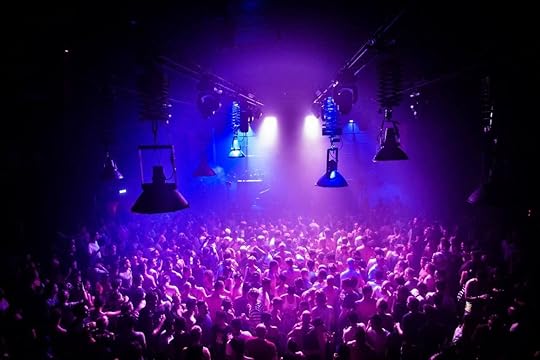
Photo: Is Burning/Facebook
Hosted at various clubs throughout the city, this party weaves underground house music, techno, and even some disco into a night of dancing for the entire LGBTQ community to enjoy.
Where: Check the website for up-to-date info on the next event.
WTF Wednesday Queer Night at Vrankrijk
Every Wednesday, and some select Saturdays, Vrankrijk hosts performances by queer visual and performance artists. This is a safe space for people of every race, gender identity, physical ability, and country of origin. Be sure to check out the vegan feast before Wednesday night’s show.
Where: Spuistraat 216
Rapido
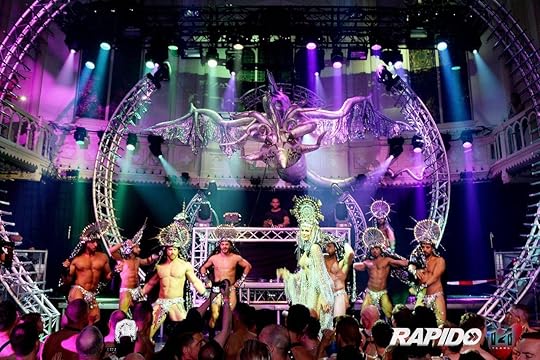
Photo: Rapido Events/Facebook
This popular party attracts a sweaty, shirtless crowd of circuit queens. Tickets usually sell out fast; parties happen about once every month at different event spaces.
Where: Check the website for dates, tickets, and locations.
Annual events
Milkshake Festival

Photo: Milkshake festival Amsterdam/Facebook
Every late July or early August, this Milkshake brings all the boys, girls, and everything in between to the yards of Westerpark for a two-day dance celebration of music, sun, and fun. The outdoor event is an all-inclusive celebration of freedom with an eclectic lineup of DJs, musicians, and performance artists spread around the event’s multiple stages. It’s a queer midsummer’s night dream. Check the website for updates.
Where: Westerpark
King’s Day
April 27 is King’s Day — a holiday honoring the current King of the Netherlands, Willem-Alexander. Known as Queen’s Day until 2013, Willem-Alexander is the first male monarch to grace the Dutch throne after 123 years of women ruling the roost. The Bacchanalian festival welcomes over a million party-goers dressed in orange to the city streets for the celebration. While it isn’t technically an LGBTQ event, there are tons of queer parties to choose from on both the 26th and 27th. Mid- to late April also happens to be peak season to see the country’s iconic tulips in full bloom — another worthy reason to visit this time of year.
Amsterdam Pride

Photo: Rayanti/Shutterstock
From the last Saturday in July to the first Sunday in August, rainbow flags fly high along Amsterdam’s canals for Pride, one of Europe’s most beloved queer celebrations. Unlike most global Pride events, which commemorate NYC’s 1969 Stonewall Riots and the birth of the Gay Liberation Movement, Amsterdam Pride began in 1996 solely as a celebration of love and diversity. There are marches, rallies, and parties to attend all week long, but the most popular event is the Canal Parade on Pride’s final Sunday. Eighty boats ride the city’s waterways from Scheepvaartmuseum, along Prinsengracht, and end at Westerdok. It’s one of the only Pride parades in the world to have floats that literally float. Nearly half-a-million people from all over the globe attend the festivities every year.
Landmarks
Homomonument

Photo: kolbet/Shutterstock
In 1987, Amsterdam unveiled the world’s first monument memorializing homosexuals persecuted under the Nazi regime.
Located in Westermarkt, thin lines of pink granite form a triangle in the square — a reclamation of the symbol gay men and women were forced to wear in concentration camps during World War II. Inside each of the triangle’s three points is a smaller triangle that directs attention to local sites of significance. One faces the National War Memorial in Dam Square where gay activists laid a lavender wreath in 1970 and were subsequently arrested, sparking the idea for this monument. Another faces Anne Frank’s house and is inscribed with a quote from a gay Jewish poet, Jacob Israel de Haan: Naar Vriendschap Zulk een Mateloos Verlangen (“Such an endless desire for friendship”). The third faces the COC Nederland headquarters, which holds the distinction of being the world’s oldest continually operating gay rights organization. Floral wreaths and bouquets are regularly laid on the triangular platform extending outward above the water of Keizergracht as a reminder of the arduous fight for equality faced by the queer community.
Where: Westermarkt
Pink Point
This LGBTQ information center and souvenir shop located next to the Homomonument has been in operation for over 20 years. In addition to the queer-themed postcards, tchotchkes, and clothing you can buy, the friendly staff is an excellent resource for insider tips about where to go and what to see as a queer tourist in Amsterdam.
Where: Westermarkt t/o 9
Parks and beaches
Vondelpark

Photo: Z. Jacobs/Shutterstock
Vondelpark is a 19th-century urban greenspace with weeping willow-lined pools, bike paths, and lawns for lounging. The rosarium, located halfway through the park, is infamously known as the most frequented gay cruising area in the city. Yes — you read that correctly — once night falls, men daring enough to drop their trousers in the great outdoors frequent this part of the park in search of pleasure. Most residents, including police, are aware of what goes on here and turn a blind eye. If you happen to fancy a rose garden triste, use caution and be careful of pickpockets.
Where: 1054 NE Amsterdam
Zandvoort Nude Beach
Zandvoort, a coastal town with an expanse of sandy shoreline facing the North Sea, is about an hour’s trip from Amsterdam, including a 20-minute walk to the beach. In the summertime, the clothing-optional area between poles 68 and 71 becomes a queer playground for naked boys looking to sunbathe near the seagrass-covered dunes.
Where: Near 2042 AG Zandvoort
Accomodation

Photo: Mr. Ngoway/Shutterstock
Amistad
This tiny gay-owned boutique hotel facing Kerkstraat is a five-minute walk from the city’s most popular gay bars on Reguliersdwarsstraat and a short stroll to Museumplein. The cozy rooms are minimalist and modern; there’s a communal breakfast served every morning.
Where: Kerkstraat 42
MisterBnB
MisterBnb is like Airbnb for the modern gay traveler. Choose from an array of homestays (single rooms, apartments, and entire row houses) listed by queer locals to fit your budget.
Where: Online
Mauro Mansion
In the 1990s, the nine rooms in this 16th-century rowhouse served as a bawdy boutique hotel for upscale gay clientele: Rooms came equipped with bondage gear, slings, and even cages. Although the company is now much more mixed than it once was, a few of the cages remain, and this hotel is still popping with personality. Amsterdam Centraal and the Red Light District are both steps away. Children under the age of 12 are not permitted.
Where: Geldersekade 16 

More like this: What you should and shouldn’t do in Amsterdam’s red-light district
The post The ultimate LGBTQ guide to Amsterdam appeared first on Matador Network.

Traditional mulled wine recipes

If you live in or are traveling to a wine-producing country in the winter, there’s a good chance you’ll come across a mug or three of warm mulled wine. The heated, spiced, and often fortified beverage is a winter tradition in nearly every wine-producing country.
It’s impossible to know who invented mulled wine (it’s one of those ideas that happened to lots of different people around the world at the same time), but it is possible to trace mulled wine’s global popularity back to the ancient Romans. The oldest recorded mulled wine recipe from that time is in Apicius, the oldest surviving cookbook of the Roman Empire.
The recipe, translated and recorded by Project Gutenberg, calls for honey, pepper, saffron, date stones, and charcoal to filter the final product. It was simmered low and slow for a day and then let rest for 24 hours before serving.
As the Romans conquered Europe, so too did mulled wine recipes. It turned out to be especially popular in Northern Europe, where it becomes imperative to stay warm as the days get shorter. Local herbs and spices available on hand made each variety distinct. Over the next thousand-plus years, mulled wine took on distinct regional names, as well.
The drink got its biggest modern endorsement in 1843 when Charles Dickens featured a recipe for a type of mulled wine called the Smoking Bishop in A Christmas Carol. From then on, mulled wine and the holiday season were inseparable in Western minds, matched only by the world’s love of eggnog.
“Every country has them,” says Aaron Goldfarb, a drinks writer for publications like Esquire and PUNCH and the author of Gather Around Cocktails. “In Europe, all that changes is the name.”
Whether you’re fighting the chill of an outdoor German Christmas market or going door to door during Las Posadas in Mexico, these are some (not all) of the various types of mulled wine you’ll come across in your travels. (Note: Unless otherwise stated, expect the recipe to include some combination of orange, red wine, and baking spices like cinnamon, nutmeg, and star anise.)
1. Brazil: quentão
In the colder southern region of Brazil, mulled wine is called quentão, which gets its name from the Portuguese word quente, or “hot.” It’s popular around Festas Juninas in June, which is the start of the winter months in the southern hemisphere. Along with local spices, it’s often spiked with cachaça, a rum-like Brazilian spirit made with raw sugarcane juice.
2. France: vin chaud
Vin chaud translates to “hot wine,” and it’s heated with honey, cinnamon, and citrus. The French typically make their mulled wine less sweet than other parts of the world. In the French Alps, aprés-ski bars are making modern versions with local white wines and Port.
3. Germany: glühwein

Photo: In Green/Shutterstock
One of the most famous of the mulled wines around the world is glühwein (which translates to “glow wine”). It’s a common aprés-ski beverage, as well as an essential drink to sip while strolling Germany’s famous outdoor Christmas markets.
4. Greece: oinomelo or krasomelo
The defining characteristic of Greek mulled wine is local wine (oino or krasi in Greek) and honey (meli). For a period of time in the Middle Ages, mulled wine in Europe was called hippocras, which took its name from the Ancient Greek physician Hippocrates.
5. Hungary: forralt bor
Forralt bor (boiled wine) is an on-the-go drink sold from stands that pops up in cities during Hungarian winters. Cinnamon, clove, honey, sugar, cardamom, and orange zest are common additions, as is rum.
6. Italy: vin brulé

Photo: francesco de marco/Shutterstock
Though this country is home to some of the first mulled wines, modern Italian mulled wine served in the north of Italy gets its name from the French word brûlé, or “burnt,” and the French word for wine, vin.
7. Mexico: ponche Navideño
Ponche Navideño is the holiday drink of choice in Mexico during Las Posadas. The nine-day celebration is meant to evoke the Biblical story of Mary and Joseph looking for an inn to stay at. Carolers travel the streets from house to house, and at each stop, their audience offers a bit of ponche Navideño to drink. While there’s no set recipe for ponche Navideño, one traditional ingredient is tejocote, or Mexican hawthorn.
8. Netherlands: bisschopswijn
Bisschopswijn translates to “bishop’s wine” though pretty much everyone gets a taste in the colder months. It’s made with sweet red wine (though sometimes white), oranges, clove, cinnamon, and allspice. It’s especially popular around the December 5 celebration of Sinterklaas.
9. Portugal: vinho quente

Photo: VK Studio/Shutterstock
Portugal’s version of mulled wine uses the country’s popular fortified wines Port and Madeira. Both are on the sweeter and boozier side, so there’s less of a need to add sugar, honey, or additional spirits.
10. Sweden and Norway: glogg
Scandinavian countries are known for their warm wine, which is called glogg. It’s typically made with red wine, port, brandy, and spices. Like glühwein in Germany, it gets its name from the word “glow,” as an earlier name was the lengthy glödgad vin. 

More like this: It’s not Christmas in Mexico without 9 days of ponche navideño
The post 10 sweet, spiced, and warming mulled wines from around the world appeared first on Matador Network.

Iceland researchers can turn CO2

Iceland’s volcanic plains are more than just otherworldly sights for tourists — the basalt rocks that lay there are about to help resolve the world’s climate emergency.
A team of researchers at the Hellisheiði geothermal plant just outside Reykjavik has managed to capture carbon dioxide emissions and store them in basalt rocks deep underground. Once infused with CO2, the rock traps the emissions forever, without any risk of pollution. The Carbfix Project is secure, cost-efficient, and brings hope to the world’s incapacity to reduce its CO2 emissions.
Andri Magnason, an Icelandic environmentalist, described one of the plant’s carbon injection wells to WBUR. “This captures 50 tons [of C02] a year,” he said. “To get 1,000 gigatons out of the atmosphere, we have to scale this up not 1 million times, but 1 billion times.”
Newer and larger wells, however, will be able to capture 1,000 times more emissions, which could ultimately make a huge impact when it comes to offsetting.
The technology can be exported since basalt is the most common rock on the planet. All that’s needed is CO2 and lots of cold water to make the industrial process work.
“If we’re going to scale this up a million times,” said Magnason, “there will be millions of jobs created.” Kári Helgason, the project’s manager, added, “it will be scaled up. We know it’s going to be scaled up. The question is whether it will be scaled up enough. And how fast.” 

More like this: How frequent flyers can offset their flight emissions
The post Scientists in Iceland can now turn carbon emissions into rock appeared first on Matador Network.

This tea company helps post-conflict

Depending on where you are, drinking tea looks different. Residents of the southeastern United States enjoy sugary iced tea on their front porches while those in England — or those who are binge-watching season three of The Crown — sip hot tea from delicate cups while chatting over scones and tiny sandwiches. But for two US Army veterans, tea became much more than a beverage. It’s a way to help people living in war-torn countries rebuild their lives.
Brandon Friedman and Terrence Kamauf, co-founders of Rakkasan Tea Company — which sources loose tea exclusively from post-conflict countries as a way to promote economic growth — were introduced to tea culture while they served together in the US Army.

Photo: Brandon Friedman
“We often had to meet and work with local leaders, especially in Iraq. Just about all business was done over tea,” Friedman says.
Building friendships offered a respite, although having tea didn’t lessen the strain of being separated from their loved ones while at war.
“Nothing really makes combat or the time away easier, but I will say that sitting down to talk to people over tea was very much an oasis amid all the chaos of combat,” Friedman continues.
Much like chatting on the porch over sweet tea or enjoying a lazy afternoon eating scones, it was those times of reprieve where both Friedman and Kamauf forged relationships with their compatriots and grew attached to Iraq and Afghanistan, where they served together.
History has shown us that war hurts civilians the most, leaving communities in desperate need of aid. Seeing the after-effects of the US army’s occupation in Iraq, Friedman wanted to help post-conflict regions while introducing others to tea culture.
“We use a fairly liberal definition of post-conflict,” Friedman explains. “To us, it essentially means any country that is still living with the repercussions wrought by an armed conflict.”
In some areas — such as Laos and Vietnam — the strife ended decades ago, and other countries, such as Colombia, experienced comparatively low-intensity conflict. Rakkasan will soon also carry tea from Myanmar, where armed conflict is still underway in some regions.
“[Kamauf] and I have seen up close what war does to communities, so it’s important to us that we help out in some way as communities work to recover, something that can literally take decades,” says Friedman. The duo believes strongly in the fact that peace and restoration can come through stimulating the economy in those countries.
Although Friedman left the army in 2004, he and Kamauf kept in touch. In 2017, Friedman was getting ready to move to Dallas while Kamauf was living in Houston, preparing for a career change. The timing was perfect for the duo to get together again, and then they decided to start the tea business.

Photo: Brandon Friedman
When it came to naming the company, they paid homage to their time serving in Iraq and Afghanistan together. The term Rakkasan stems from the Japanese word for parachutist, which was also the nickname of their unit in the US Army’s 101st Airborne Division.
Networking has helped the veterans find tea farms, but the sourcing differs for each country. Their preference is to work directly with the farmer or owner of the tea estate. In some cases, experts who frequent the regions help source tea that upholds Rakkasan’s standards. One of their advisory board members sources the Nepalese tea as she splits her time between Kathmandu and the US.
For some countries, the quality of the tea can be an issue. Such was the case with Vietnam, which is known for tainted tea. Rakkasan enlists a tea expert who is knowledgeable about the country’s problems with contamination, and he provides Rakkasan with tea tested for chemical residue and heavy metals.
“Vietnam is notorious for low-quality, pesticide-laden tea,” Friedman says. “We source all of our Vietnamese tea from wild tea trees which are too large for pesticide use anyway.”
Rakkasan has grown since its inception. Its co-founders continue to strive to impact post-conflict countries while introducing others to “the excellent flavors and expert craftsmanship of tea makers who are growing in places that aren’t China, India or Japan,” Friedman says. The duo not only spends their days fulfilling online orders and managing inventory, but they also concentrate on growing their business by reaching out to retail partners and letting patrons taste their teas at local markets in the Dallas area.
The response has been reassuring for these army veterans. Not only are they supporting their families and encouraging people to try new teas and flavors from different regions, but they are positively impacting post-conflict areas.
“You also know that by buying our tea, you’re helping the economies of countries ravaged by war,” Friedman says. 

More like this: How foraged Colorado herbs kickstarted America’s love of herbal tea
The post Why two army veterans started a tea company to help countries recover from war appeared first on Matador Network.

Win a writer’s retreat in the UK

A cottage in the British countryside might be the perfect environment in which to write that novel you’ve been mulling over for the past decade, and now you might just get your chance at that idyllic retreat. Holiday Cottages, in collaboration with UK book publisher Pan Macmillan, is offering a seven-night getaway to one of its three properties in the UK, all located in the bucolic countryside that has inspired some of the world’s most famous authors.
Winners will be able to choose from a cottage in East Sussex that was once home to Virginia Woolf and Rudyard Kipling; a house in Carmarthenshire, Wales, where Dylan Thomas was inspired by the surrounding lakes and hills; and a third property in east Scotland, a region often frequented by Robert Louis Stevenson and Robert Burns. Whichever accommodation you pick, you’ll have everything you need to bring your novel idea to fruition, including a typewriter, dictionary, thesaurus, notepad, pen, coffee, and reading material for inspiration.

Photo: Holiday Cottages

Photo: Holiday Cottages

Photo: Holiday Cottages
To enter, tweet a summary of your novel idea with the hashtag #WriTweet by midnight on January 24, 2020. The best entry will be chosen by Elizabeth Macneal, a New York Times bestselling author.
And if you can write up to 10,000 words during your stay, Macneal will provide expert feedback on your work. 

More like this: The 7 best cities in the world for book lovers
The post Your novel idea could win you a writer’s retreat in the British countryside appeared first on Matador Network.

ESA to spend robot to clean space

The European Space Agency (ESA) has just announced that a self-destructing robot will be sent into orbit on the world’s first space cleanup mission. The goal of the mission, named ClearSpace One, is to clean up dead satellites, discarded rockets, paint flecks, and other debris currently stuck in Earth’s orbit.
Designed by Swiss startup ClearSpace, the robot itself will function by latching onto debris before diving back down to Earth, where the machine and its attached garbage will burn up in the atmosphere.

Photo: ClearSpace/Facebook
Luc Piguet, ClearSpace founder, said, “This is the right time for such a mission. The space debris issue is more pressing than ever before. Today we have nearly 2,000 live satellites in space and more than 3,000 failed ones.”

Photo: European Space Agency
The first mission, set to launch in 2025, will target the Vespa, an ESA cone-shaped rocket left in orbit in 2013.
Currently, the robot can only clean up one piece of debris at a time, but there are plans for it to eventually collect multiple objects in one trip. And there is a lot of work to do — according to the ESA, there are currently over 900,000 pieces of debris larger than 1 centimeter (0.4 inches) floating into space.
“Imagine how dangerous sailing the high seas would be if all the ships ever lost in history were still drifting on top of the water. That is the current situation in orbit, and it cannot be allowed to continue,” explained ESA Director General Jan Wörner.
On top of removing the debris currently in Earth’s orbit, space agencies are looking to develop technologies that would avoid creating more space junk. 

More like this: 6 space travel projects that will become a reality in our lifetime
The post Europe plans to send a self-destructing robot to clean up space appeared first on Matador Network.

French train strikes creates chaos

Transportation strikes in France have been causing mayhem for 12 consecutive days, and as the holidays are approaching, travelers are becoming anxious about their travel plans.
Changes to the pension system promised by French President Emmanuel Macron during his presidential campaign are coming, and in an attempt to prevent the overhaul, unions are relentlessly organizing strikes, blocking the entire country.
This morning, over 370 miles of traffic jams in and around Paris were reported, more than double the usual average traffic congestion of 155 to 186 miles. Commuters are opting to drive to work today as eight Metro lines are shut down and the rest of the Metro, trains, buses, and trams are heavily disrupted.
On Tuesday, December 17, unions are expected to stage a third day of protest marches with teachers and other public sector workers.
Although the government has been putting pressure on unions to end the strikes before the holidays, unions don’t seem to be budging. The CGT rail workers union even issued a grim “No truce at Christmas” warning last week, unless the government withdraws its planned pension reforms. 

More like this: The 6 most unusual methods of transportation around the world
The post French transit strikes threaten holiday travel appeared first on Matador Network.

Matador Network's Blog
- Matador Network's profile
- 6 followers



